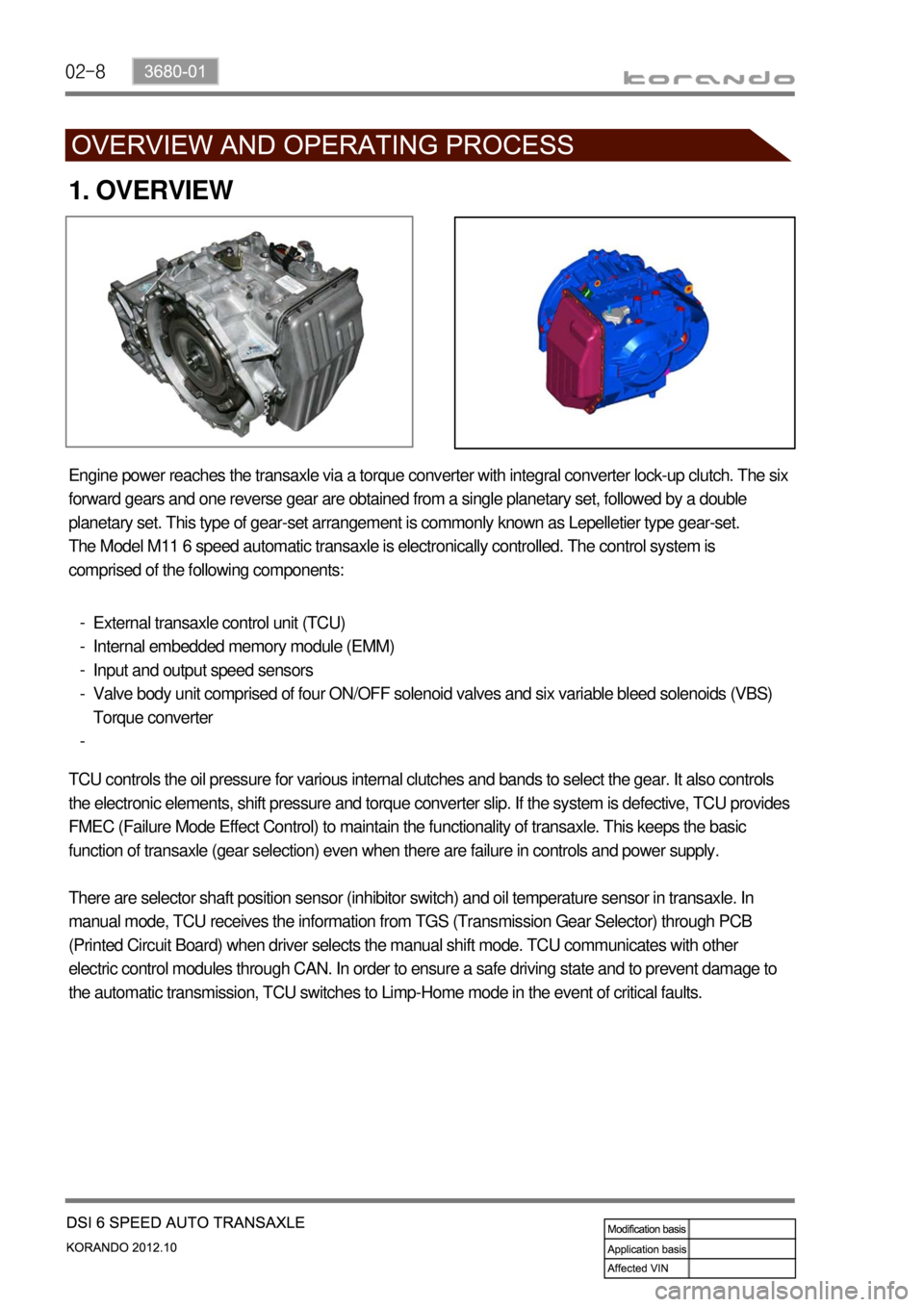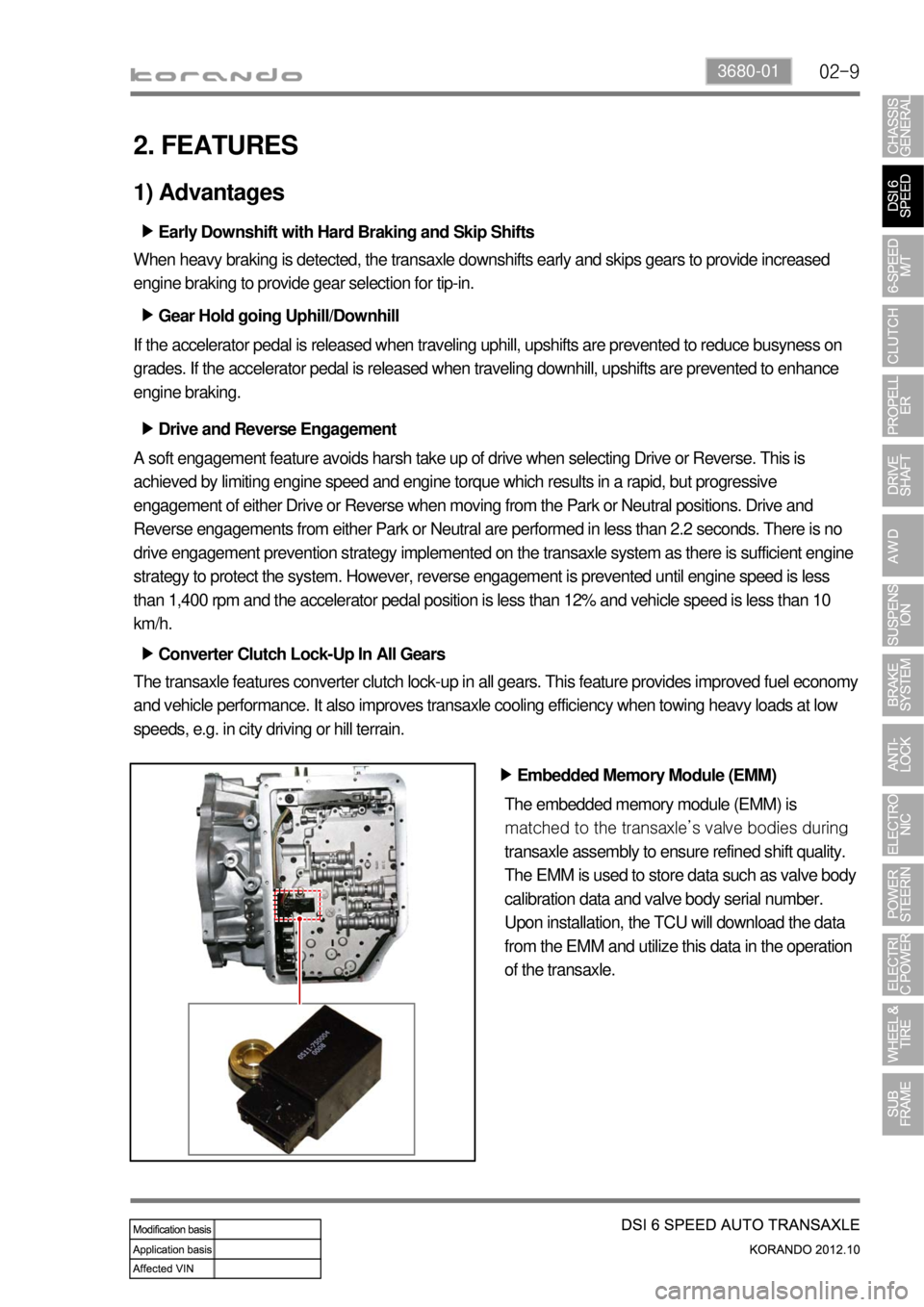Valve body SSANGYONG KORANDO 2012 User Guide
[x] Cancel search | Manufacturer: SSANGYONG, Model Year: 2012, Model line: KORANDO, Model: SSANGYONG KORANDO 2012Pages: 1082, PDF Size: 96.1 MB
Page 341 of 1082

01-170000-00
Electronic throttle body
4. INTAKE SYSTEM
Air cleaner element
VIS valveVIS solenoid valve
Intake manifold assembly
T-MAP sensor
Page 388 of 1082

04-6
T-MAP sensorVIS valve
1. OVERVIEW
To improve the engine performance, the VIS system has been introduced in the intake manifold. It
<009700990096009d0090008b008c009a0047009b008f008c004702c8007300960095008e00470079009c00950095008c009902c9004700900095004700930096009e0047009a0097008c008c008b004700880095008b0047009b008f008c004702c8007a00
8f00960099009b00470079009c00950095008c009902c90047>in high speed.
And, to reduce the internal pulsation in the intake manifold, the Runner # 1 and #2 are located in
symmetry
p<0096009a0090009b0090009600950047009e0090009b008f00470079009c00950095008c00990047004a005a004700880095008b0047004a005b00550047007b009600470099008c008b009c008a008c0047009b008f008c00470088009000990047009900
8c009a0090009a009b00880095008a008c00530047009b008f>e throttle body is tilted b
2. COMPONENTS
VIS solenoid valve
Intake manifold assembly
Page 389 of 1082

04-70000-00
Purge control solenoid
valve
Blow-by hosePCV valve
Electronic throttle bodyAir cleaner element
Page 406 of 1082

05-71745-01
1. OVERVIEW
This system purifies the exhaust gas generated by the combustion in the engine to reduce the pollutants
and noise during that arise during combustion.
Harmful materials produced in the combustion process is treated and reduced in the exhaust system.
Harmful materials discharged from the crankcase and fuel tank is drawn into the intake system again to
reduce discharge amount of harmful materials.
Emission aftertreatment system ▶
Catalytic Converter & O2 Sensor
The catalytic converter is a monolith type purification system composed of cordierite which purifies
exhaust gas through the small holes of active monolith catalyst from the exhaust manifold. As exhaus
t
gas passes through the small holes in the layer in the middle, its CO and HC are reduced by
oxidization reaction and its NOx is reduced by reduction reaction to Pt, Ph and Pd. The oxygen
sensor sends signals for feedback and determination of catalyst condition. For detailed description,
see the corresponding section. -
The fuel evaporative gas is a gas evaporated to the atmosphere in the section between the fuel tank and
fuel line, and its main component is hydrocarbon (HC). The fuel evaporative gas is temporarily stored in
the canister, and it is drawn to the engine through the throttle body when the purge control solenoid valve
is open according to the engine operating condition.
Gas in the combustion chamber is sealed by the piston. However, gas is leaked through the gap
between the cylinder and piston and drawn into the crankcase during the compression and explosion
strokes. This gas is blow-by gas and its main components are hydrocarbon and carbon monoxide. If this
gas is drawn into the crankcase, the system can be corroded and oil can be deteriorated. Also, if this
gas is discharged into the air, it can pollute the environment. To prevent these, the blow-by gas
reduction system (also called as crankcase ventilation system) draws the blow-by gas from the
crankcase to the combustion chamber for combustion.
Purge Canister Control ▶
Blow-by gas control system (crankcase ventilation system) ▶
Page 470 of 1082

15-50000-00
Purge control
solenoid valve
G20DF engine
ECUCoolant Temp
sensorCamshaft position
sensor
Crankshaft position
sensor
T-MAP sensorVIS solenoid valveElectronic throttle
bodyMagnetic trigger
ring
Front oxygen
sensor
Page 507 of 1082

02-8
Swirl control valve
It operates variably in accordance with the
engine load and rpm.
Refer to Chapter “Engine Control”.
Intake manifold
It is the passage for intake air when the swirl
vale is operating. The T-MAP sensor for
measuring the pressure and temperature of
pressurized air in turbocharger is installed on
the left top of intake manifold.
3. LAYOUT OF INTAKE SYSTEM
1) Overview
The intake system for D20DTF(Low CO2) engine is equipped with a throttle body which includes a flap.
This flap is controlled by an electrical signal to cut off the intake air entering to the engine when the
ignition switch is turned off. The intake manifold contains the swirl control valve and dual port system to
make the optimum turbulence. The T-MAP sensor is located on the left top of the intake manifold and
the HFM sensor for precise control is located at the rear side of air cleaner. To reduce the intake noise
and to improve the intake efficiency, the volume of air cleaner has been increased.
2) Components
Electric throttle body
Refer to Chapter “Engine Control”.
Page 841 of 1082

02-73680-01
3. TIGHTENING TORQUE
DescriptionsSize x
NumbersTightening torque
(Nm)
Automatic transaxleEngine side mounting bolt 17 mm X 4 85.0 to 100
Oil pan and engine side mounting
bolt14 mm X 4 56.0 to 62.0
Oil filler plug 16 mm 25.0 to 30.0
Oil drain plug Hexagon 5 mm 25.0 to 30.0
Valve bodyAssembly mounting screw T30 mm X 9 16.0
Oil pan bolt 10 mm X 15 7.0 to 8.0
VBS screw T30 mm 4.0
Valve body screw T30 mm X 25 16.0
Torque converter Mounting bolt 13 mm X 6 40.0 to 42.0
CableLink nut (switch side) 13 mm X 1 13.7 to 19.6
Link nut (cable side) 12 mm X 1 14.7 to 22.5
Mounting nut (floor side) 12 mm X 1 17.6 to 21.6
Mounting nut (dash panel side) 12 mm X 2 17.6 to 21.6
TGS lever Mounting nut 12 mm X 4 17.6 to 21.6
TCU Mounting nut 8 mm X 2 5.0 to 6.0
Inhibitor switch Mounting nut 12 mm X 2 3.9 to 7.8
Transaxle bracketLeft bracket 17 mm X 3 85.0 to 100
Right bracket 17 mm X 4 85.0 to 100
Upper bracket 17 mm X 4 85.0 to 100
Oil cooler pipeMounting bolt 10 mm X 2 Max.: 13.0
Bracket mounting bolt 10 mm X 1 13.0
Page 842 of 1082

02-8
1. OVERVIEW
Engine power reaches the transaxle via a torque converter with integral converter lock-up clutch. The six
forward gears and one reverse gear are obtained from a single planetary set, followed by a double
planetary set. This type of gear-set arrangement is commonly known as Lepelletier type gear-set.
The Model M11 6 speed automatic transaxle is electronically controlled. The control system is
comprised of the following components:
External transaxle control unit (TCU)
Internal embedded memory module (EMM)
Input and output speed sensors
Valve body unit comprised of four ON/OFF solenoid valves and six variable bleed solenoids (VBS)
Torque converter -
-
-
-
-
TCU controls the oil pressure for various internal clutches and bands to select the gear. It also controls
the electronic elements, shift pressure and torque converter slip. If the system is defective, TCU provides
FMEC (Failure Mode Effect Control) to maintain the functionality of transaxle. This keeps the basic
function of transaxle (gear selection) even when there are failure in controls and power supply.
There are selector shaft position sensor (inhibitor switch) and oil temperature sensor in transaxle. In
manual mode, TCU receives the information from TGS (Transmission Gear Selector) through PCB
(Printed Circuit Board) when driver selects the manual shift mode. TCU communicates with other
electric control modules through CAN. In order to ensure a safe driving state and to prevent damage to
the automatic transmission, TCU switches to Limp-Home mode in the event of critical faults.
Page 843 of 1082

02-93680-01
2. FEATURES
1) Advantages
Early Downshift with Hard Braking and Skip Shifts ▶
When heavy braking is detected, the transaxle downshifts early and skips gears to provide increased
engine braking to provide gear selection for tip-in.
Gear Hold going Uphill/Downhill ▶
If the accelerator pedal is released when traveling uphill, upshifts are prevented to reduce busyness on
grades. If the accelerator pedal is released when traveling downhill, upshifts are prevented to enhance
engine braking.
Drive and Reverse Engagement ▶
A soft engagement feature avoids harsh take up of drive when selecting Drive or Reverse. This is
achieved by limiting engine speed and engine torque which results in a rapid, but progressive
engagement of either Drive or Reverse when moving from the Park or Neutral positions. Drive and
Reverse engagements from either Park or Neutral are performed in less than 2.2 seconds. There is no
drive engagement prevention strategy implemented on the transaxle system as there is sufficient engine
strategy to protect the system. However, reverse engagement is prevented until engine speed is less
than 1,400 rpm and the accelerator pedal position is less than 12% and vehicle speed is less than 10
km/h.
Converter Clutch Lock-Up In All Gears ▶
The transaxle features converter clutch lock-up in all gears. This feature provides improved fuel economy
and vehicle performance. It also improves transaxle cooling efficiency when towing heavy loads at low
speeds, e.g. in city driving or hill terrain.
Embedded Memory Module (EMM) ▶
The embedded memory module (EMM) is
matched to the transaxle’s valve bodies during
transaxle assembly to ensure refined shift quality.
The EMM is used to store data such as valve body
calibration data and valve body serial number.
Upon installation, the TCU will download the data
from the EMM and utilize this data in the operation
of the transaxle.
Page 867 of 1082

03-73660-01
4. COMPONENTS
HPT 6A/T (6F24)
One-way clutchTorque converter
(with slip lockup)
Oil pumpHarness
Valve bodySide gearDriven gear